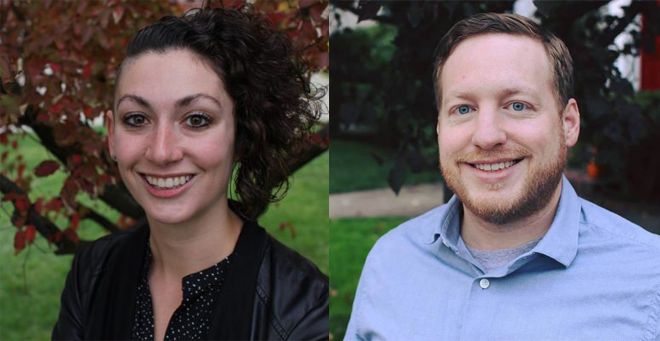 |
|
|
Melissa Anderson, PhD, and Tim Riker |
Melissa Anderson, PhD, assistant professor of psychiatry at UMass Medical School, Tim Riker, lecturer of American Sign Language at Brown University’s Center for Language Studies, and colleagues have been working to address low levels of health literacy within the Deaf community, due in part to the disconnect between biomedical researchers and the Deaf population.
The collaboration, led by Dr. Anderson, integrates Riker’s cultural and linguistic expertise with the expertise of clinicians and researchers. A group of Deaf community advisors—laypersons from the Deaf community who advise on how best to meet the needs of their peers—rounds out the research team.
“The objective is to understand the social, political and historical experience of Deaf people and to transform health research in order to improve population health,” Riker said.
The team conducted focus groups and community forums with Deaf individuals to collect information on how hearing researchers can do a better job of including Deaf people in biomedical research, Anderson said. They developed and tested a new research methodology, which they outlined in a recent commentary in the journal Qualitative Health Research.
Cracking the code on effective qualitative research within the Deaf community could help address a range of health issues, Riker and Anderson said.
“Mental illnesses, addiction and trauma within the Deaf community are higher than among the general population,” Riker said. “Rates of obesity, diabetes, suicide, domestic violence and sexual or intimate partner violence are also higher, along with other types of health disparities.”
While reduced health literacy and its negative health outcomes arise in part from reduced incidental learning—for example, through overhearing and understanding conversations or spoken health information disseminated by radio or televised public service announcements—Deaf sign language users also often miss the chance to engage with health providers and health researchers, Riker said.
Some methods used in data collection, like telephone surveys, are inaccessible to some sign language users, and health researchers often do not include the interpreters and video technology needed to interview Deaf subjects as they plan their research, Riker said.
Written materials can also be problematic, according to Riker and colleagues. Median English reading level among the Deaf population falls at approximately the fourth-grade level. This is due, Riker said, to lack of resources and systemic failures related to early language acquisition and literacy. And ASL “is fully distinct from English—that is, it is not ‘English on the hands,’” the researchers wrote, but has its own structure and syntax. To move between ASL and English, ASL must be translated, rather than transcribed. When such translations are conducted by hearing researchers, they can be inaccurate or biased, the authors noted.
“As a hearing researcher within the Deaf community, I have to be aware of my limitations,” Anderson said. “It’s always important to be partnering with people who truly understand Deaf experience to avoid pursuing research questions that are not important, not appropriate or even offensive to Deaf people.”
To engage the Deaf community, which has had negative experiences with biomedical researchers, according to Riker, the group used the truth and reconciliation model—a form of fact-finding perhaps best known for its use in post-Apartheid South Africa.
“We use the model to help to heal, to come together collaboratively and to make suggestions and recommendations,” Riker said. “The Deaf community was part of the research from the beginning. In the past, non-Deaf people would lead research without the Deaf community being involved. This is a more integrative type of research and an even exchange.”
Jeroan Allison, MD, professor of quantitative health sciences at UMMS, has used the truth and reconciliation model to engage underserved black and Latino communities in biomedical research with good results, Anderson said: “We applied that same process of listening to the transgressions of the majority world, apologizing and trying to move forward together.”
A new methodology
In developing and testing the new research methodology, Riker, Anderson and colleagues considered everything from the composition of the research team to specific technological concerns. They recommend reforming research practice in the following ways:
- Cultivate a Deaf-majority research team to provide cultural and linguistic expertise as well as input on study design, interpretation and strategies for disseminating findings to the Deaf community.
- Collect data directly in the primary language of the participants (ASL) using a sign-only environment.
- Use multiple video streams to fully capture what is being expressed, including facial expressions, which can impact the meaning of an utterance.
- Upload video data into a qualitative analysis software package for coding without first transcribing it. This allows the researchers to code both linguistic and nonlinguistic data that a text translation would miss.
- Analyze data collaboratively to interpret the meaning of Deaf participants’ statements without personal or cultural biases.
- Disseminate findings back to key Deaf stakeholders and the lay community through open-access products and ASL research briefs.
- In disseminating findings to the scientific community, translate only salient direct quotes, rather than the entire dataset, into English, with the guidance of community advisors who serve as linguistic experts and cultural brokers. This preserves data in its original form, rather than as a body of translated material.
The research team created a 40-minute training video that demonstrates how to interact with Deaf research participants, specifically during the informed-consent process. The researchers are developing a larger grant proposal for an expanded five-year project that will test the efficacy of the training intervention.
[Editor's note: Per the recommendation of the National Center on Disability and Journalism's Disability Language Style Guide, the word "Deaf" is capitalized in reference to members of the Deaf community and lowercase in reference to the hearing-loss condition.]